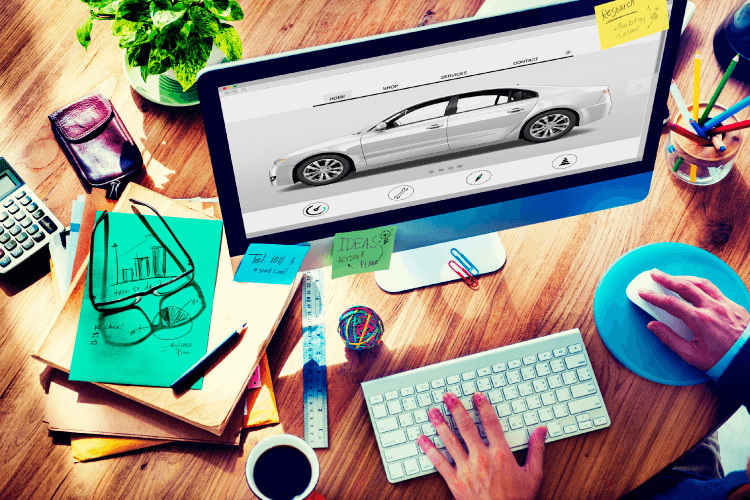The pandemic has left its mark on all industries and many businesses worldwide and the automotive industry is among those facing major challenges. The changes impacted the supply chain and production as well as its ability to meet customer demand. To date, the industry has already adjusted to the new situation somewhat, but for its long-term recovery it will be even more important to take into account the changing consumer purchasing patterns and habits, as well as the changing media/advertising landscape.

In this post, I will highlight some of the trends and tools that the automotive industry can use to turn the tables, rethink its marketing activities and direct its advertising resources to the right channels.
Create rich digital experiences throughout the customer journey
Consumers have already become accustomed to the convenience of shopping online from the comfort of their home and new sales channels will remain with us (at least partially). Nevertheless, when it comes to major purchases, consumers still require more than an attractive photo and a comprehensive set of product details to make a decision. It’s still difficult to imagine adding a new car to an online shopping cart as if you were purchasing groceries or a new phone.
Direct interaction with the car or the dealer remains the most important part of the car-buying process. What has changed significantly over the past year is that such interactions are no longer necessarily tied to physical space. Research shows that shoppers are increasingly making their purchase decisions online, and only visit the point of sale to complete the formalities. The customer journey itself takes several months, consisting of many micro-moments when you can offer the customers rich digital experiences and keep them engaged throughout the entire purchase journey.

The automotive industry has benefited from a wide array of digital channels that allow them to reach their target audiences in innovative ways. I’m sure the following set of tips and ideas will help you unlock these potentials, but to get you started, here are at least three things to keep in mind:
- Be accessible to customers throughout the entire purchase journey and across different digital channels.
- Be helpful and convenient. If customers can’t come to you, go to them.
- Be quick. Gone are the days of the “slow is smooth” approach.
Make a strong first impression
Digital transformation has opened up new dimensions for interacting with target audiences, where you can create an even better first impression in a virtual environment than in person. As many as 80% of new and existing car buyers start their purchase journey by visiting third-party websites and they also look for information on websites of car dealers and OEMs and through search engines.
Develop a marketing strategy that includes all of these digital channels and, most importantly, ensure a seamless online presence with an intuitive and engaging website. Use quality blog posts and creative solutions to improve your website’s user experience and search engine rankings. Create an online configuration tool for your customers to design their dream car or provide additional information in the form of e-catalogues, and then use social media to promote your content marketing efforts.

Use video to get closer to users
Take traditional media content and turn it into short videos, engaging car interior and exterior video presentations, expert video reviews, video competitions between different car models, test drive demonstrations or even video games. If you make sure the video is displayed properly on mobile devices, your imagination is the only limit.
Offer a 1-on-1 consultation with your expert or the ability to view a car via video conferencing. For an even deeper relationship, use chatbots or chat apps to engage your customer in a personal and relaxed way. And of course, don’t forget about the security and privacy standards of online users.

Be relevant and unobtrusive
Today, technology allows you to track user behaviour patterns on a unified basis and across all platforms. Use the data you collect about your users to tailor your message to different customer profiles and prevent them from being driven away from your brand because of retargeting.
Impress with innovation
The automotive industry can use innovative virtual reality (VR) and augmented reality (AR) technologies to elevate the user experience. Enhance the display of your offering with life-size 3D models and environments, virtual walks or virtual displays that allow users to change the colour of the selected car model at will. With the rapid advances in technology, the automotive industry can also expect to see a more widespread use of upgraded digital channels and formats, such as virtual showrooms.

Connect with car enthusiasts rather than influencers
The Influencer Marketing Hub recently warned that nano- and micro-influencers are increasingly standing out in influencer marketing. Despite having fewer followers, bigger brands are increasingly turning to them since their followers trust them more and identify with them more easily.
In the future, we can expect influencers to specialise even more in their own niches or industries, presenting themselves not as celebrities and content creators but rather as perfectly ordinary people with their own interests and hobbies: writers, photographers, chefs or, last but not least, admirers of great cars. You should look for people who have a passion for the automotive industry, support your company’s mission and will recommend your brand for reasons other than mere profit.

Neither the automotive giants nor anyone else can be certain when the global situation will settle down, what the long-term consequences of the pandemic will be, or what challenges the industry will face in the future. But one thing is certain: Today, digital marketing skills are a standard, not an optional accessory. Do you have everything you need to take a successful journey towards your customers?
